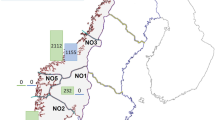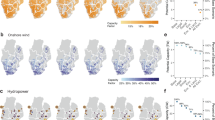Abstract
Replacement of conventional energy sources with renewables such as solar panels and wind turbines requires adequate land. Impact assessments should be conducted to identify sites exhibiting least conflict with current and future land-uses and corresponding ecosystem services. We assessed the electricity potential and geographical distribution of wind turbines and solar panels for current land-use and under three Swiss land-change scenarios. The future scenario A2 with limited construction regulations, a liberalized market and more building surfaces increases the electricity potential of solar panels by 69% from 16.6 TWh (potential under current land-use and regulations) to a future 28.2 TWh. An increase of approximately 26% electricity potential from solar panels is expected for scenario B2 (regionalized economy) and the trend scenario. Wind-electricity potential could increase by 61% from 93 to 150 TWh under A2, and 29% under a B2 or trend scenario. The electricity potential for solar panels remains largely unaffected by conflicts with ecosystem services, but electricity production from wind could be reduced by as much as 98% due to conflicts with ecosystem services. Depending on the scenario used, low-conflict sites for solar panels and wind turbines could contribute between 85% (trend and B2 scenario) and >100% (A2 scenario) to the Swiss energy target of generating 25 TWh from new renewable energy sources by 2050. This includes expected technological developments. Positive impacts of sustainable energy production on regional economies are moderate and will not lead to strong changes in regional-economic development.



Similar content being viewed by others
Notes
Nature protection sites are not an exclusion criterion for scenario A2.
References
Akademien der Wissenschaften (2012) Lösungsansätze für die Schweiz im Konfliktfeld erneuerbarer Energien und Raumnutzung. Bern
Baumgartner D, Pütz M, Seidl I (2013) What kind of entrepreneurship drives regional development in European non-core regions? A literature review on empirical entrepreneurship research. Eur Plan Stud 21:1095–1127. doi:10.1080/09654313.2012.722937
BFS (2008) Eidgenössische Betriebszählung 2008, inklusive Land- und Forstwirtschaft. Neuenburg
BFS (2016a) Beherbergungsstatistik. https://www.bfs.admin.ch/bfs/de/home/statistiken/tourismus.gnpdetail.2016-0160.html. Accessed 26 Nov 2016
BFS (2016b) Population scenarios. https://www.bfs.admin.ch/bfs/de/home/statistiken/bevoelkerung/zukuenftige-entwicklung/schweiz-szenarien.html. Accessed 6 Dec 2016
Buchecker M, Kienast F, Degenhardt B, Widmer S, Moritzi M (2013) Naherholung räumlich erfassen. Merkblatt für die Praxis 51:1–8
Calvert K, Mabee W (2015) More solar farms or more bioenergy crops? Mapping and assessing potential land-use conflicts among renewable energy technologies in eastern Ontario, Canada. Appl Geogr 56:209–221. doi:10.1016/j.apgeog.2014.11.028
Cattin R, Schaffner B, Humar-Mägli T, Albrecht S, Remjund J, Klauser D, Engerl JJ (2012) Energiestrategie 2050. Berechnung der Energiepotenziale für Wind-und Sonnenenergie. METEOTEST, Wetterprognosen, erneuerbare Energien, Luft und Klima, Umweltinformatik, Bern
Cornaro C, Bartocci S, Musella D, Strati C, Lanuti A, Mastroianni S, Penna S, Guidobaldi A, Giordano F, Petrolati E, Brown TM, Reale A, Di Carlo A (2015) Comparative analysis of the outdoor performance of a dye solar cell mini-panel for building integrated photovoltaics applications. Prog Photovolt 23:215–225. doi:10.1002/pip.2426
de Castro C, Mediavilla M, Miguel LJ, Frechoso F (2011) Global wind power potential: physical and technological limits. Energy Policy 39:6677–6682. doi:10.1016/j.enpol.2011.06.027
de Castro C, Mediavilla M, Miguel LJ, Frechoso F (2013) Global solar electric potential: a review of their technical and sustainable limits. Renew Sustain Energy Rev 28:824–835. doi:10.1016/j.rser.2013.08.040
de Groot R (2006) Function-analysis and valuation as a tool to assess land use conflicts in planning for sustainable, multi-functional landscapes. Landsc Urban Plan 75:175–186
De Schepper E, Van Passel S, Manca J, Thewys T (2012) Combining photovoltaics and sound barriers—a feasibility study. Renewable Energy 46:297–303. doi:10.1016/j.renene.2012.03.022
Diouf B, Pode R (2015) Potential of lithium-ion batteries in renewable energy. Renewable Energy 76:375–380. doi:10.1016/j.renene.2014.11.058
Egli T, Bolliger J, Kienast F (2017) Evaluating ecosystem service trade-offs with wind electricity production in Switzerland. Renew Sustain Energy Rev 67:863–875
EUR-Lex Access to European Union Law (2011) Greenhouse gas: reducing emissions by 20% or more by 2020
Frantal B (2015) Have local government and public expectations of wind energy project benefits been met? Implications fro repowering schemes. J Environ Planning Policy Manage 17:217–236. doi:10.1080/1523908X.2014.936583
GEA (2012) Global energy assessment—toward a sustainable future. Cambridge University Press, Cambridge
Grêt-Regamey A, Weibel B, Kienast F, Rabe S-E, Zulian G (2015) A tiered approach for ecosystem services mapping. Ecosyst Serv 13:16–27. doi:10.1016/j.ecoser.2014.10.008
Grilli G, Balest J, De Meo I, Garegnani G, Paletto A (2016) Expert’s opinions on the effects of renewable energy development on ecosystem services in the Alpine region. J Renew Sustain Energy 8:013115. doi:10.1063/1.4943010
Grubler A, Bai X, Buettner T, Dhakal S, Fisk DJ, Ichinose T, Keirstead JE, Sammmer G, Satterthwaite D, Schulz NB, Shah N (2012) Urban energy systems. In: GEA (ed) Global energy assessment—toward a sustainable future. Cambridge University Press, Cambridge, 1330 pp
Haines-Young R, Potschin M (2013) Common international classification of ecosystem services (CICES). Report to the European Environment Agency
Hastik R, Basso S, Geitner C, Haida C, Poljanec A, Portaccio A, Vrščaj B, Walzer C (2015) Renewable energies and ecosystem service impacts. Renew Sustain Energy Rev 48:608–623. doi:10.1016/j.rser.2015.04.004
Heinbach K, Aretz A, Hirschl B, Prahl A, Salecki S (2014) Renewable energies and their impact on local value-added and employment. Energy Sustain Soc 4:1–10. doi:10.1186/2192-0567-4-1
Henning HM, Palzer A (2012) 100% erneuerbare Energien für Strom und Wärme in Deutschland. Report Fraunhofer-Institute for Solar Energy Systems ISE. Accessed on 26 Nov 2016 from https://www.ise.fraunhofer.de/de/veroeffentlichungen/veroeffentlichungen-pdf-dateien/studien-und-konzeptpapiere/studie-100-erneuerbare-energien-in-deutschland.pdf
Horch P, Schmid H, Guélat J, Liechti F (2013). Konfliktpotenzialkarte Windenergie—Vögel Schweiz: Teilbereich Brutvögel, Gastvögel und Vogelschutzgebiete gemäss WZVV. Erläuterungsbericht. Aktualisierung 2013. Schweizerische Vogelwarte, Sempach
Infras (2010) Stromeffizienz und erneuerbare Energien. Wirtschaftliche Alternative zu Grosskraftwerken, Zürich
Jaeger JAG, Schwick C (2014) Improving the measurement of urban sprawl: Weighted Urban Proliferation (WUP) and its application to Switzerland. Ecol Ind 38:294–308. doi:10.1016/j.ecolind.2013.11.022
Kienast F, Buergi M, Wildi O (2004) Landscape research in Switzerland: exploring space and place of a multi-ethnic society. Belgeo 2–3:369–384
Kienast F, Bolliger J, Potschin M, de Groot RS, Verburg PH, Heller I, Wascher D, Haines-Young R (2009) Assessing landscape functions with broad-scale environmental data: insights gained from a prototype development for Europe. Environ Manage 44:1099–1120. doi:10.1007/s00267-009-9384-7
Kienast F, Degenhardt B, Weilenmann B, Wager Y, Buchecker M (2012) GIS-assisted mapping of landscape suitability for nearby recreation. Landsc Urban Plan 105:385–399. doi:10.1016/j.landurbplan.2012.01.015
Kienast F, Frick J, van Strien MJ, Hunziker M (2015) The Swiss Landscape Monitoring Program—a comprehensive indicator set to measure landscape change. Ecol Model 295:136–150. doi:10.1016/j.ecolmodel.2014.08.008
Kienast F, Huber N, Hergert R, Bolliger J, Segura Moran L, Hersperger A (2017) Conflicts between decentralized renewable electricity production and landscape services—a spatially-explicit quantitative assessment for Switzerland. Renew Sustain Energy Rev 67:397–407. doi:10.1016/j.rser.2016.09.045
Kirchner A (2012) Die Energieperspektiven für die Schweiz bis 2050. Energienachfrage und Elektrizitätsangebot für die Schweiz 2000–2050, Ergebnisse der Modellrechnungen für das Energiesystem. Prognos, AG. Eidgenössisches Departement für Umwelt, Verkehr, Energie und Kommunikation UVEK und Bundesamt für Energie BFE. 842
Kontogianni A, Tourkolias C, Skourtos M, Damigos D (2014) Planning globally, protesting locally: patterns in community perceptions towards the installation of wind farms. Renewable Energy 66:170–177. doi:10.1016/j.renene.2013.11.074
Korcaj L, Hahnel UJJ, Spada H (2015) Intentions to adopt photovoltaic systems depend on homeowners’ expected personal gains and behavior of peers. Renewable Energy 75:407–415. doi:10.1016/j.renene.2014.10.007
Kosfeld R, Gückelhorn F (2012) Ökonomische Effekte erneuerbarer Energien auf regionaler Ebene. Raumforsch Raumordn 70:437–449
Liechti F, Guélat J, Komenda-Zehnder SBC (2013) Modelling the spatial concentrations of bird migration to assess conflicts with wind turbines. Biol Conserv 162:24–32. doi:10.1016/j.biocon.2013.03.018
Michel AH, Buchecker M, Backhaus N (2015) Renewable energy, authenticity, and tourism: social acceptance of photovoltaic installations in a Swiss alpine region. Mt Res Dev 35:161–170. doi:10.1659/mrd-journal-d-14-00111.1
Moriarty P, Honnery D (2012) What is the global potential for renewable energy? Renew Sustain Energy Rev 16:244–252. doi:10.1016/j.rser.2011.07.151
Moriarty P, Honnery D (2016) Can renewable energy power the future? Energy Policy 93:3–7. doi:10.1016/j.enpol.2016.02.051
Palmas C, Siewert A, von Haaren C (2015) Exploring the decision-space for renewable energy generation to enhance spatial efficiency. Environ Impact Assess Rev 52:9–17. doi:10.1016/j.eiar.2014.06.005
Pasqualetti MJ (2011) Opposing wind energy landscapes: a search for common cause. Ann Assoc Am Geogr 101:907–917. doi:10.1080/00045608.2011.568879
Patel S (2015) New approach powers bladeless wind turbine. Power 159:14–16
Price B, Kienast F, Seidl I, Ginzler C, Verburg PH, Bolliger J (2015) Future landscapes of Switzerland: risk areas for urbanisation and land abandonment. Appl Geogr 57:32–41. doi:10.1016/j.apgeog.2014.12.009
Ramachandra TV, Shruthi BV (2007) Spatial mapping of renewable energy potential. Renew Sustain Energy Rev 11:1460–1480. doi:10.1016/j.rser.2005.12.002
Raupach-Sumiya J, Matsubara H, Prahl A, Aretz A, Salecki S (2015) Regional economic effects of renewable energies—comparing Germany and Japan. Energy Sustain Soc 5:1–17. doi:10.1186/s13705-015-0036-x
Renewable Energy Directive (2009) Directive 2009/28/EC of the European Parliament and the Council of April 23 2009 on the promotion of the use of energy from renewable sources and amending and subsequently repealing Directives 2001/77EC and 2003/30/EC, 5.6.2009
Ribi F, Buser B, Felten NV, Walther R, Bernath K (2012) Regionalökonomische Potenziale und Erfolgsfaktoren für den Aufbau und Betrieb von Energieregionen. Studie im Auftrag von Bundesamt für Raumentwicklung (ARE), Bundesamt für Energie (BFE), Bundesamt für Landwirtschaft (BLW) und Staatssekretariat für Wirtschaft (seco) Bern
SATW (2006) Swiss Academy of Engineering Sciences: Roadmap Erneuerbare Energien Schweiz. Bern
SFSO BfS (2013) Land use in Switzerland: results of the Swiss land use statistics. Neuchatel
Smallwood KS (2013) Comparing bird and bat fatality-rate estimates among North American wind-energy projects. Wildl Soc Bull 37:19–33. doi:10.1002/wsb.260
Solarserver (2016). Mehr als 2300 Quadratkilometer Gebäudefläche für Photovoltaik und Solarthermie nutzbar. Accessed on 26 Nov 2016 from http://www.solarserver.de/news/news-7381.html
Stoeglehner G, Neimetz N, Kettl KH (2011) Spatial dimensions of sustainable energy systems: new visions for integrated spatial and energy planning. Sustain Soc 1:1–9. doi:10.1016/j.renene.2010.01.018
Stoll BL, Smith TA, Deinert MR (2013) Potential for rooftop photovoltaics in Tokyo to replace nuclear capacity. Environ Res Lett. doi:10.1088/1748-9326/8/1/014042
Taylor PC, Turner JA (2012) Renewable energy incentives: subsidies or subventions? J Renew Sustain Energy. doi:10.1063/1.4730619
Tsoutsos T, Frantzeskaki N, Gekas V (2005) Environmental impacts from the solar energy technologies. Energy Policy 33:289–296. doi:10.1016/s0301-4215(03)00241-6
Verburg PH, Overmars KP (2009) Combining top-down and bottom-up dynamics in land use modeling: exploring the future of abandoned farmlands in Europe with the Dyna-CLUE model. Landscape Ecol 24:1167–1181. doi:10.1007/s10980-009-9355-7
Wissen Hayek U, Jaeger JAG, Schwick C, Jarne A, Schuler M (2011) Measuring and assessing urban sprawl: what are the remaining options for future settlement development in Switzerland for 2030? Appl Spat Anal Policy 4:249–279. doi:10.1007/s12061-010-9055-3
Wolsink M (2007) Wind power implementation: the nature of public attitudes: equity and fairness instead of ‘backyard motives’. Renew Sustain Energy Rev 11:1188–1207. doi:10.1016/j.rser.2005.10.005
Acknowledgements
We are grateful for valuable input from the Editor and two reviewers on earlier versions of the manuscript. We thank our interview partners from three leading renewable energy offices: Urs Elber from PSI (Paul Scherrer Institute, Villigen), 13 October 2014; Andreas Fürholz from ZHAW (Zurich University of Applied Sciences, Wädenswil), 21 October 2014; Oliver Kohle from Kohle & Nussbaumer SA (Lausanne), 11 November 2014. This project was financed by three WSL internal grants to Bronwyn Price, Nica Huber and Rico Hergert.
Author information
Authors and Affiliations
Corresponding author
Additional information
Editor: Helmut Haberl.
Nica Huber, Rico Hergert, Marco Pütz, Felix Kienast and Janine Bolliger have contributed equally to this work.
Electronic supplementary material
Below is the link to the electronic supplementary material.
Rights and permissions
About this article
Cite this article
Huber, N., Hergert, R., Price, B. et al. Renewable energy sources: conflicts and opportunities in a changing landscape. Reg Environ Change 17, 1241–1255 (2017). https://doi.org/10.1007/s10113-016-1098-9
Received:
Accepted:
Published:
Issue Date:
DOI: https://doi.org/10.1007/s10113-016-1098-9




